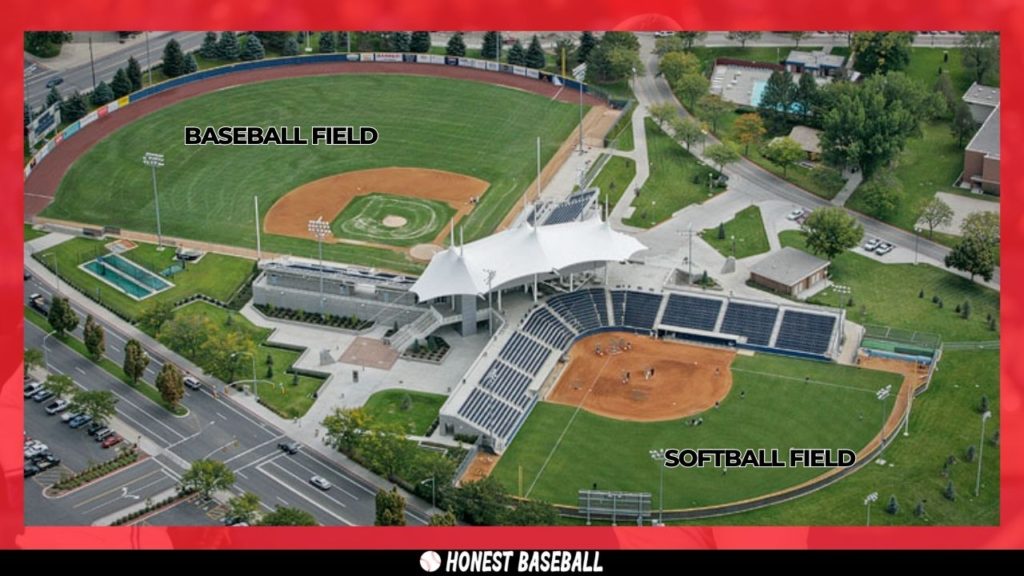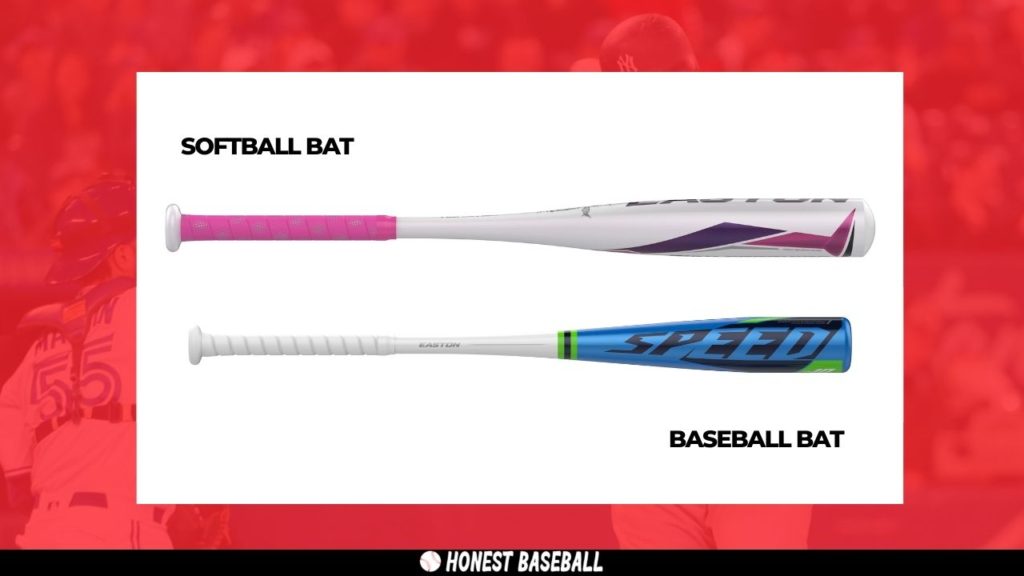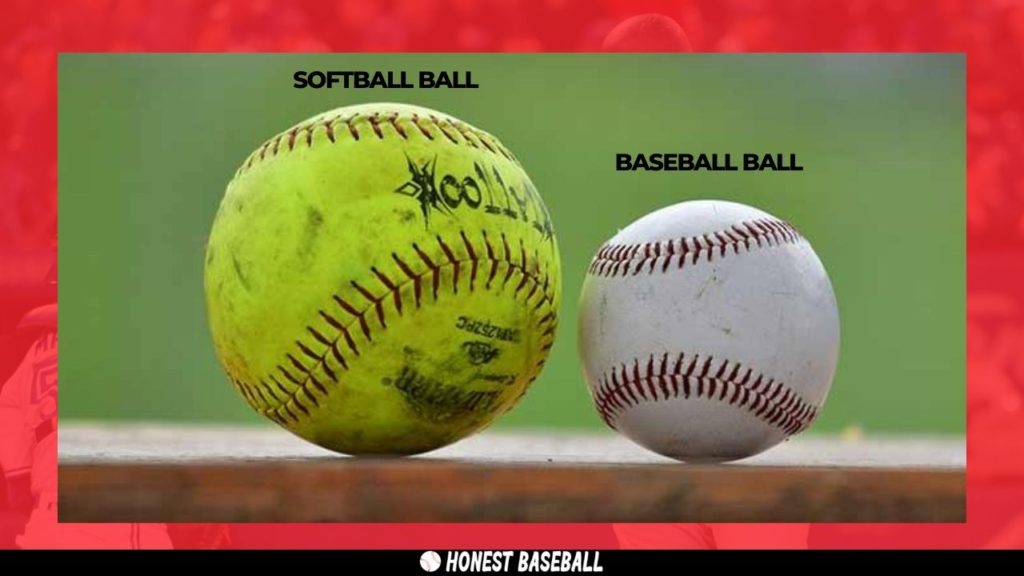Last Updated on August 13, 2023
There are 8 notable differences between softball and baseball, including field measurements, bat and ball size, gameplay, number of players, and pitching.
For instance, softball fields have a closer base path and smaller infield and outfield areas compared to baseball ballparks.
In addition, the pitching mounds on softball fields are flatter and have a smaller diameter than those in baseball.
Even both sports require different sizes, weights, and colors of balls in professional leagues. Not that much, but yet the bats used in both games vary considering the length, weight, and barrel size.
To get a deeper understanding of the factors that make both popular sports different, make sure to read till the end.
Top 8 Differences in Softball and Baseball
Softball and baseball have a lot of dissimilarities in field measurements, bat and ball size, gameplay, pitching, etc. Let’s take a deeper look at them one by one.
1. Difference Between Softball And Baseball Fields

When it comes to finding the differences between softball and baseball, the field or playground comes first. There are a lot of dissimilarities in the ball fields of both games. For example;
Softball Has Closer Basepath Than Baseball
Unlike baseball, softball was first introduced as an indoor sport. Hence, from its inception, softball has a less-distant basepath, only 60 feet.
“However, modern softball is played both in indoor and outdoor ballparks but the basepath distance remains the same.”
On the other hand, as an outdoor sport, baseball has a longer basepath, which is 90 feet. Because of this, you can see softball fields have a smaller infield area compared to baseball fields.
Softball Fields Have Smaller and Flatten Pitching Mounds Compared to Baseball
Another notable difference between softball and baseball fields is the pitching mounds. Softball fields feature a flattened or level pitching mound.
“The pitching mound is an area from where both softball and baseball pitchers throw the ball toward the batter.”
But in Major League Baseball fields, the pitching mounds are slightly raised up to 10 inches. There are height differences in the baseball pitching mounds also depending on the league.
For instance, it’s 6-8 inches in youth baseball leagues and 6 inches in Little League baseball. Also, the pitching mound height is extended to 8 inches in high school baseball leagues.
Pretty much goes for the pitching mound diameter of both games. Professional softball fields feature pitching mounds having a minimum of 16 feet in diameter.
On the contrary, Major League Baseball pitching mounds are at least 18 feet in diameter.
Baseball Fields Have a Larger Skinned Infield Than Softball
The radius of the baseball-skinned infield area is 95 feet, whereas softball fields have 65 feet. Some more size differences in the infield area of the baseball and softball fields are:
| Description | Softball | Baseball |
| Home Plate To Backstop Distance | 25 Feet | 60 Feet |
| Home To Front Of Rubber | 50 Feet | 60 Feet 6 Inches |
| Home To Second Base Distance | 91’ 11 | 127’ 3 3/8 |
| Home Plate Circle Diameter | Variety | 26 Feet |
“The table is based on the required field measurements for professional league baseball and softball. In some lower leagues, these data can change a little.”
The Outfield Area of Softball Is Different From Baseball Ballparks
Without the infield area, there are also a few differences in the outfield zone of softball and baseball fields.
If you take a closer look at the distances between the dugout/coach box and the foul line, home plate, and left field or center field, you’ll get a better idea. Check out the below table for a side-by-side comparison:
| Description | Softball | Baseball |
| Distance Between Dugout/Coach Box And Foul Line | 8 feet | 15 feet |
| Home Plate to Center Field Distance | 315 feet | 400 feet |
| Home Plate to Left Field Distance | 265 feet | 320-350 feet |
“The table only demonstrates required field measurements of both sports in professional league baseball and softball. In some leagues, the information differs slightly.”
2. Softball and Baseball Bats’ Lengths, Weights, and Barrel Diameter Are Different

As there are very subtle differences in bats in both sports, many people wonder if they can use softball bats for baseball. However, there are still some considerable differences such as the length, weight, and barrel sizes of softball and baseball bats.
Softball Bats Length Is Smaller Than Baseball Bats
For pro league softball, the maximum bat length permission is up to 86.36 cm 34 inches. Looking at the counterpart, Major League Baseball allows players to use bats having a length of up to 42 inches.
“According to USA rules, baseball bats can’t be more than 32 inches in length for 10-12 years and not more than 34 inches for 13-17 years.”
Baseball Bats Are Heftier Than Softball Bats
You’ll even see some differences in the bat’s weight also. For instance, softball bats can’t be more than 1.88 lbs. Or 30 ounces. But an MLB baseball bat’s weight can be anything between 33 to 36 ounces (2.06 to 2.25 lbs.)
The Barrel Size of Softball Bats Is a Bit Smaller Than Baseball Bats
Yes! Even though there is a very subtle barrel diameter difference between softball and baseball bats, you can’t ignore it.
While professional softball bats feature 2.25 inches of diameter, average MLB baseball bats have 2.75 inches.
“For USA Baseball tournaments, the barrel size can’t be more than 2 5/8 inches.”
3. The Color, Size, and Weight of Softball and Baseball Balls Are Different

You can see the differences between softball and baseball balls at first glance. Firstly, softball balls are fluorescent optic yellow, while baseball balls are white. However, both balls have red seams.
“Though the seams styles are similar, both the radius of the seams is different. Therefore, the gripping style is also different.”
Without the color appearance, both balls also have dissimilarities in size or dimensions. Softball balls feature a minimum of 11.88 inches to a maximum of 12.13 inches in diameter. On the flip side, baseball balls are a bit smaller, ranging from 9 to 9.25 inches in diameter.
Another common difference is the ball’s weight. Softball balls weigh heavier than baseball balls, featuring 6.25 to 7 ounces. And balls used in professional baseball events weigh around 5-5.25 ounces.
4. Pitching Differences in Softball and Baseball

In softball and baseball, there are some differences in both pitching styles and pitcher’s location.
The distance between the pitching mound and home plate is 40 to 46 feet in softball and in the baseball field, it’s 60.6 feet.
Due to the smaller distance of the pitcher to batter, softball rules state that pitchers can only toss the ball underhand.
Typically, softball pitchers grip the ball using their index, middle and ring fingers on the seam and pinky fingers on the side of the ball. However, the gripping style can be changed in different slow-pitch softball pitching.
In contrast, baseball pitchers have to pitch overhand as they need to create more force to throw the ball at a longer distant batter. So, to achieve the force, they grip the ball keeping their index and middle fingers on the seam.
“Amateur Women, High-school, College/International leagues softball fields feature a consecutive pitcher-batter base distance of 40 feet, 43 feet, and 46 feet. ”
5. Match Duration and Innings Differences in Softball and Baseball
The match duration is basically considered based on the total innings time. Softball games feature a total of 7 innings, while average MLB games have 9 innings. Although the innings range in baseball differs a lot based on the league levels.
Because of the fewer number of innings, softball games usually last 1.5 to 2 hours. But baseball matches can last far longer than that.
According to the last 10 MLB seasons, average baseball games last around 3 hours. So, you should pack yourself with another hour of patience when attending a live baseball match.
“In 1981, a baseball match between the Rochester Red Wings and Pawtucket Red Sox extended to 33 innings! As a result, it took 8.25 hours to complete the match.”
6. Softball Has More Players Compared to Baseball
It’s needless to mention that each baseball team requires 9 players to participate in a game. The baseball players’ positions are:
- Pitcher
- Catcher
- First baseman
- Second baseman
- Third baseman
- Shortstop
- Left fielder
- Center fielder
- Right fielder
In fastpitch softball, there are also 9 concurrent players in the play. But in slow-pitch softball, 10 players can participate in a game. These are;
- Pitcher
- Catcher
- First baseman
- Second baseman
- Third baseman
- Shortstop
- Left fielder
- Center fielder
- Right fielder
- Roamer or Rover
“A roamer or rover is an additional defensive player in the slow pitch softball who is positioned in the outfield area.”
7. Softball Infielders Wear Protective Gear, Unlike Baseball Infielders
As you’ve read earlier, softball pitchers are positioned at least 20 feet closer to the batter’s plate than what we see in baseball. Besides, the infield area in softball is shrunk compared to its counterpart.
Therefore, there is a higher risk of injuries for softball infielders like being hit by the batter’s ball.
To mitigate this issue, it’s common for softball infielders to wear face masks and cups for their safety against powerful line drives.
8. Lead-Off In Softball But Not in Baseball
The Lead-off refers to the distance of a baserunner from his base. In baseball, baserunners can take a slight lead or advance a little from their current base before and during pitchers deliver the pitch. However, it’s not allowed in softball leagues to lead off before the pitching delivery.
8 Similarities Between Softball And Baseball
Yeah, they don’t only have fights to discuss. There are some similarities between softball and baseball, making them popular among both sports fans. For instance:
- The scoring system in softball and baseball is the same. In both games, offensive teams try to score more to win a game by hitting home runs or advancing bases.
- Softball and baseball have a similar diamond-shaped field, including 4 bases and a pitcher’s mound.
- Equipment used in softball and baseball by defensive players, including the shape of gloves, catcher’s mitt, and protective gear, is the same.
- Both softball and baseball bats can be made of wood, alloy, or composite materials.
- Fast-pitch softball and baseball have similar 9 players positions on the defensive team.
- Some fundamental rules, like force out, strike outs, home runs, etc., are the same in baseball and softball.
- The battings drills and fielding drills for baseball and softball are pretty much the same.
- Bunting, stealing bases, etc., terms, and rules are the same in both games.
Frequently Asked Questions
Softball Vs Baseball Which Is Harder?
If you consider fast-pitch softball, it’s harder than baseball. It’s because, in fast-pitch softball, the distance between the pitcher and the batter is around 40-43 feet. Therefore, the batter gets less reaction time to hit the ball.
Without that, for infielders, fast-pitch softball is also harder than baseball as there is a high chance of close encounters due to the smaller-skinned infield area.
What is the difference between softball and baseball gloves?
Although the shape of both gloves is the same, there is a difference between softball and baseball gloves, considering the size. Softball balls are larger than baseball balls. Thus, most defensive players’ gloves are larger in softball compared to baseball.
Check out the below table demonstrating gloves’ sizes for over 14 years for both sports. For a deeper understanding, check out my article on whether can you use softball gloves for baseball.
| Player Positions | Softball (in inches) | Baseball (in inches) |
| Pitcher | 11.5-12.5 | 11.5-12 |
| Catcher | 33-35 | 32-34.5 |
| First Base | 12-13 | 12-13 |
| Second Base/Shortstop | 11.5-12.5 | 11.25-11.5 |
| Third Base | 11.75-12.5 | 11.5-12 |
| Outfield | 12-13 | 12-13 |
Are softball and baseball rules different for stealing bases?
The stealing base rules differ between softball and baseball. In softball, runners can only leave the base when the pitcher releases the ball. But in baseball, runners can leave the base as soon as the pitcher starts their delivery.
Wrapping Up
No doubt, there are significant differences between softball and baseball. But these differences are required for the nature of both sports. And honestly speaking, these are what make them favorites for 2 genres of sports lovers, fans, and athletes.
If you found this article helpful, please share this with your community and friends on social media who often get confused between both sports.
Check out more about softball vs. baseball:
Can I Use Baseball Gloves For Softball?
Can Baseball Bats Be Used For Softball?
Why Do Girls Play Softball And Boys Play Baseball (Sexism Or Law)

Hello everyone. My name is Jason Butler, and I live in California, America. I was a professional AAA Minor League Baseball player. I lost my chance of playing MLB for injury issues, but I did not lose my love for baseball. I attended the coaching training program and am now working as a coach in a small school in San Diego.
I always love to share my experience and knowledge if that can help you. Play baseball, and stay fit.
